DESCRIPTION |
LEGENDS OF THE GODS |
Athens, Greece: Pre-Tour Shore Excursion
"Walking in Plato's Footsteps"
($ Extra Charge)
Wed. Oct. 9, 2024
8-hour tour
Time TBD
Activity Level: Easy
Early-bird special rate expires anytime
REGISTER HERE NOW
Tour Description
Taste the vital flavors of Athens while enjoying guided tours of the Acropolis and the National Archeological Museum. The Acropolis, a World Heritage Site, is the most striking and complete ancient Greek complex dating back to the 5th century BCE. The monument was built celebrating the cultural and political achievements of Athens and is the most famous site in all of Athens.
The National Archeological Museum is home to the world's most exquisite collection of Greek antiquities found in any single location. Here you will witness the art of Greeks emphasizing rational thinking centered around the individual human; the foundation of democracy.
If the Acropolis and National Archeological Museum weren't enough, proceed to the district of Plaka, the oldest neighborhood in Athens. Here an authentic Greek meal will be prepared and served for your enjoyment. After your lunch, enjoy time at your leisure in Plaka, the historic heart of town. As you walk the narrow paved streets, you'll discover Neoclassical mansions, quaint cafes, and the retail hub of Monastiraki Flea Market. A tour of this magnitude provides a rich sense of ancient Athenian culture and deliciousness.
Included
Round trip transportation from your hotel to the Acropolis, National Archeological Museum, and Plaka along with entrance fees to the historic sites, and lunch.
Not Included
Expenses including snacks, shopping, and other leisurely activities at Plaka are not included in the price of the tour.
Food and Beverage
Lunch consists of fried eggplant or zucchini, tzatziki, Greek salad, spinach pie, Greek souvlaki with potatoes and rice and seasonal Fruits. Beverages are water and table wine.
Recommended Dress
Comfortable clothing, sensible, flat-soled walking shoes, sunglasses, sunscreen, and hat or umbrella are suggested.
Restrictions
The minimum age to consume alcohol is 21. Guests must be able to walk over cobblestones and uneven surfaces, inclines and steps. This tour is not wheelchair accessible.
Meeting Instructions
Details will be provided on your ticket.
REGISTER HERE NOW
|
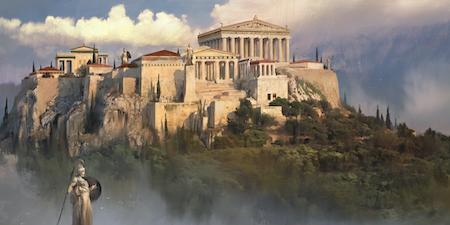
Legend of the Acropolis
Our adventure begins and ends in Athens. Walk the path of ancient mystics, as we visit the Acropolis, the “birthplace of democracy,” where Socrates and Plato debated on white marble steps. Charged with effervescent ideas that shaped our civilization… The energy is still there to tap into.
At the very heart of the Acropolis stands a testament to the rivalry between Athena and Poseidon. According to legend, both deities coveted the city, offering gifts to claim it. Poseidon struck the rock with his trident, bringing forth a spring, while Athena offered the olive tree, symbolizing peace and prosperity. The city’s inhabitants chose Athena’s gift, thus naming the city Athens. The marks of Poseidon’s trident and the sacred olive tree are said to be found on the Acropolis, reminding visitors of this divine contest.
The Acropolis is not only home to the gods but also to the tales of fierce creatures like the centaurs. The mythical half-man, half-horse beings were known for their battle with the Lapiths, which is depicted in the metopes of the Parthenon. This myth serves as a reminder of the eternal struggle between civilization and barbarism. It is a theme that resonates throughout Greek mythology.
The Erechtheion, with its porch of Caryatids, tells the poignant story of these maiden statues. Legend has it that they represent the women of Caryae, punished by being forced to bear the weight of the temple’s roof for betraying Athens. The Caryatid Women, adorned in elegant dresses and exhibiting poised stature, symbolize two contrasting concepts. They represent both the burden of treachery and the dignity of eternal service. Their presence offers visitors an evocative narrative to contemplate.
The Acropolis is also the backdrop for the heroic sagas of Theseus. Theseus is the legendary king of Athens who defeated the Minotaur. Legends say that Theseus walked these very grounds, and the festivals held in his honor connected mortals with the divine. His tales of bravery and adventure echo through the marbled pathways and continue to inspire those who climb the Acropolis Hill.
REGISTER HERE NOW
|
|
Alexandria, Egypt
"Legends of the Pharoahs"
($ Extra Charge)
Sat. Oct. 12, 2024
8-hour tour
Time TBD
Activity Level: Easy
Early-bird special rate expires anytime
REGISTER HERE NOW
Tour Description
During your day in Egypt, you will drive across the desert to Cairo and the Pyramids of Giza. The Cheops Pyramid is the sole survivor among the Seven Wonders of the Ancient World.
Shore Excursion Includes:
• Transportation from Alexandria port to Giza & Sakkara and drive back to Alexandria port.
• Entry ticket to Sakkara area.
• Visit the area of the Step pyramid.
• Visit the Serapeum.
• Visit one of the tombs
• Lunch at local restaurant
• Drive to Giza.
• Entry ticket to Giza pyramids area.
• Visit the valley temple.
• Visit the Sphinx (public area).
• Drive to Alexandria port.
Meeting Instructions
Details will be provided on your ticket.
REGISTER HERE NOW
|

Legend of the Pyramids
Edgar Cayce taught that the secrets of Atlantis and knowledge of the future are buried under the right front paw of the Sphinx at the foot of Giza Plateau.
Built thousands of years ago, the pyramids remain enigmas to scientists as well as to seekers of the unknown.
The first person to enter the Great Pyramid of Cheops in post-Pharaonic times was the caliph of Baghdad, Abdullah al-Ma’mun, in AD 820. He forced his way in by heating rocks, then breaking them by pouring on vinegar.
As generations of scientists and tourists, eccentrics and treasure hunters followed him, pyramid mystique grew over the ages.
Perhaps the most famous personality to enter in search of the occult was Napoleon Bonaparte, who spent the night of Aug. 12, 1799, inside Cheops’ pyramid and emerged ashen and shaken.
He went to his grave in 1821 without telling what he experienced.
“No! What’s the use,” Napoleon was said to have told a friend. “You wouldn’t believe me anyway.”
Cheops is made of 2.3 million blocks, each one weighing 2 1/2 tons to 15 tons, each side at an angle of 51 degrees, 50 minutes and 35 seconds. Many people think the pyramids were built by extra-terrestrials, or survivors from the lost continent of Atlantis.
REGISTER HERE NOW
|
|
Limassol, Cyprus
"The Cult of Aphrodite"
($ Extra Charge)
Sun. Oct. 13, 2024
5-hour tour
Time TBD
Activity Level: Easy
Early-bird special rate expires anytime
REGISTER HERE NOW
Tour Description
On our way to Paphos we will stop at Petra tou Romiou. Petra tou Romiou or Aphrodite’s Rock as it is known is the legendary birthplace of the goddess Aphrodite-Cypria. A spectacular beach with awe-inspiring views, this beautiful stretch of pebble coast is where the Greek goddess of love rose from wave and foam. Guests can have a short break to admire the magnificent view and take some memorable photos.
Our trail starts from the Church of Panayia Chrysopolitissa, built in the 13th century over the ruins of the largest Early Byzantine basilica on the island. Within the compound one can see St. Paul's Pillar, where according to tradition; the saint was flogged before the Roman Governor Sergius Paulus converted to Christianity.
The city is home to Mosaics of the Roman period, dating from around the 3rd century AD. These are situated in four main houses: the House of Aion, House of Dionysos, House of Orpheus and House of Theseus,
They include many attention-grabbing geometrical decorations and draw inspiration from Greek mythological scenes.
Food and Beverage
Passengers can enjoy their meal at a local restaurant at their own expense.
Recommended Dress
Comfortable clothing, sensible, flat-soled walking shoes, sunglasses, sunscreen, and hat or umbrella are suggested.
Meeting Instructions
Details will be provided on your ticket.
REGISTER HERE NOW
|
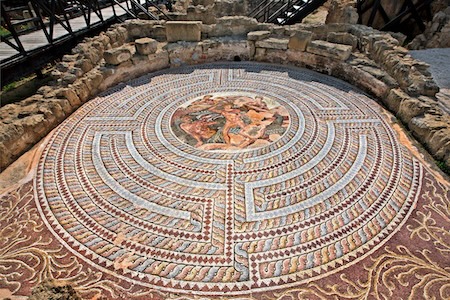
Legend of Aphrodite
Legend has it that Paphos was home of Aphrodite, goddess of beauty and love. Still under the spell of the goddess, the area retains her magic and has remained intact by time. It seduces its visitor with its majestic landscape, lovely coastline and historical treasures. Paphos itself is a leading cultural centre of the Mediterranean and the whole town is on the World Heritage list.
Wherever one treads in Paphos one comes across a glorious history which dates back thousands of years, when the cult of goddess Aphrodite flourished in this beautiful part of the world attracting many visitors from inland and abroad.
REGISTER HERE NOW
|
|
Atalya, Turkey
"Echoes of Ancient Anatolia"
($ Extra Charge)
Mon. Oct. 14, 2024
8-hour tour
Time TBD
Activity Level: Easy
Early-bird special rate expires anytime
REGISTER HERE NOW
Tour Description
Experience the wonders of ancient Anatolia, where history, culture, and natural beauty intertwine seamlessly. Our first stop is Perge Ancient City, where echoes of a glorious past still resonate in the air. Marvel at the remarkably preserved ruins of this once-great metropolis, with its towering columns, intricate mosaics, and majestic gates. In the Perge amphitheater, ancient dramas once played out against the backdrop of the Anatolian sky.
Next, we venture to Aspendos, which boasts the best-preserved Roman theater in Turkey, and one of the best in the world. Prominent features include the best-preserved Roman Stadium in Western Turkey, exquisite Roman Baths, towering Hellenistic Defenses, and long rows of beautiful colonnaded streets.
Side (SEE-deh) is a Turkish Mediterranean village amid marble Roman ruins on 2 km (1.2 miles) of unspoiled beach. Discover a historical town comprised of ancient structures, beautiful beaches, and an old city town. When visiting Side, you can travel back in time while walking in this pedestrian-only town with a total of 29 different structures to visit.
The most popular Hellenistic and Roman ruins include: The Theatre, Temple of Apollo, State Agora, City Gate, and Episcopal Palace and Basilica. While performing restoration works, the ground stones have been protected by a layer of glass. You can walk over the ancient remains without harming them. Feel the whispers of ancient audiences as you gaze upon the stage where performances once enthralled crowds centuries ago.
But our journey doesn't end there.
Prepare to be enchanted as we make our way to Kursunlu Waterfalls, a tranquil oasis nestled amidst lush greenery. Let the sound of cascading water soothe your soul as you take in the breathtaking beauty of this natural wonder.
Finally, we conclude our adventure with a visit to Side, a charming seaside town where history meets modernity. Explore its quaint streets lined with ancient ruins, bustling bazaars, and quaint cafes. Whether you choose to relax on the golden sands of its pristine beaches or delve further into its rich history, Side promises an unforgettable end to our journey.
REGISTER HERE NOW
|

Legends of Antalya
Antalya showcases thousands of years of history in the form of an amazing Old Town, nearby historical ruins and a striking landscape. The historic center of Antalya, called Kaleiçi (Old Antalya), surrounds the Roman Harbor. There are many entrances to Kaleici, but the most stunning is walking through the three large arches of Hadrian's Gate, built for the Roman Emperor Hadrian for his visit in 130 AD. Many of the buildings here date from Ottoman and Roman times. From atop the cliff of the old town are panoramic views of Antalya Marina (Kaleiçi Yat Limanı) and the sparkling Mediterranean Sea.
The Archaeological Site of Perge was added to the World Heritage Tentative List in 2009.
Perge is a starting point for the St. Paul Trail leading north up to the Anatolian plateau. This stunning ancient city contains some of the most beautiful Hellenistic and Roman Ruins in Turkey. The city is rich with history as Alexander the Great once strode through its gates, and the Apostle Paul preached there on his missionary journeys.
Aspendos was a thriving ancient city and important to the politics of the Pamphylian region. In 333 B.C. Alexander the Great conquered the city and demanded a tax on the city’s remarkable horse breeding exports.
In 133 BC the city was annexed to the Roman Empire with the rest of the Pamphylian region.
The stunning Aspendos theater was constructed at the command of the Roman Emperor Marcus Aurelius (161-180 AD). Aspendos includes a substantial aqueduct, agora, basilica, and stadium. In 2015, the site was added to the World Heritage’s Tentative List.
Food and Beverage
Not Included
Recommended Dress
We recommend wearing comfortable clothing and sensible, flat-soled walkingshoes. Sunscreen and sunglasses are also recommended.
Restrictions
Guests must be able to walk over cobblestones and uneven surfaces, inclines, and steps. This tour is not wheelchair accessible.
Meeting Instructions
Details will be provided on your ticket.
REGISTER HERE NOW
|
|
Kos, Greece
"Relaxation in Heavenly Waters"
($ Extra Charge)
Tue. Oct. 15, 2024
7-hour tour
Time TBD
Activity Level: Easy
Early-bird special rate expires anytime
REGISTER HERE NOW
Tour Description
Embark our wooden boat and leave Kos behind you as you set sail for spectacular places.
Our first destination will be the south-east Pserimos, where you will have the opportunity to dive in the Aegean crystal-clear waters.
Next, we deck to Pserimos harbor, with enough time to relax on its powder white sands and dip in its shallow waters. Here you can also enjoy traditional Greek cuisine in the local tavernas.
Various starters and small appetizers it’s a must, before you enjoy a tasteful Greek meal!
Leaving Pserimos for a short cruise, about 20 minutes, and you will reach the deserted islet of Plati. This is a small uninhabited islet, without any buildings apart from the orthodox church of Saint Nicholas. Enjoy this remote and tranquil place or try snorkeling around!
After this stop, you will head to Vathi Bay, on the island of Kalymnos. Dive from the boat to the deep blue waters and gaze at the infinite Aegean Sea. You will, also, have free time to wander around and, perhaps, visit the local shops of Vathi.
Enjoy an amazing cruise in deserted and beautiful beaches, where you can calm and relax while enjoying the beautiful Greek sun.
Food and Beverage
Lunch will be available for purchase by passengers.
Recommended Dress
We recommend wearing comfortable clothing and sensible, flat-soled walking shoes. Wear bathing suit under clothing. Sunscreen and sunglasses are also recommended. Bring a beach towel that you may check out at the ship's pool.
Restrictions
Guests should be able to get in and out of the vehicle and vessel on their own.
Meeting Instructions
Details will be provided on your ticket.
REGISTER HERE NOW
|

Legends of the Aegean
Arriving at Pserimos, you will find Avlakia, the only village on the island, built on the site of an ancient settlement. Even today, remnants of ancient dwellings can be seen, and parts of pottery dating back to Hellenistic times are often found in the sand. You can also find the most popular beach of the island, distinguished for its white sand and shallow waters.
From the small port of Pserimos begins the uphill path which leads by a short route to the beach of Panagia Grafiotissa, where the small white chapel dominates, built on the site of an earlier Christian church.
Plati is a tiny island situated between Pserimos and Kalymnos.
According to one of the travel guides, Plati island was only inhabited by a couple of people.
There is a story that Greeks felt it was too dangerous for them to have an uninhabited island near the Turkish border, so the government subsidised a house for someone who was willing to settle on the island.
No matter how many changes people of Kalymnos have seen, their life is uniquely attached to the sea, as well as to danger. Sponge divers, fishermen, adventurous, resourceful, cunning, conscientious, hospitable people... these are some descriptions concerning people who made this island famous.
Some of the most beautiful rock climbing routes in Europe can be found on this island and the name of Kalymnos has become known all over the world.
REGISTER HERE NOW
|
|
Izmir
(Ephesus), Turkey
"Wonders of the Ancient World"
($ Extra Charge)
Wed. Oct. 16, 2024
5 1/2 hour tour
Time TBD
Activity Level: Easy
Early-bird special rate expires anytime
REGISTER HERE NOW
Tour Description
Meet your professionally trained tour guide and set out for a fascinating Private Ephesus, Turkey Tour. The ancient city is an approximate 75-minute drive from Izmir. Famous in antiquity for its Temple of Artemus during the years of the Roman Empire, the Greek port of Ephesus became the greatest city in Asia Minor.
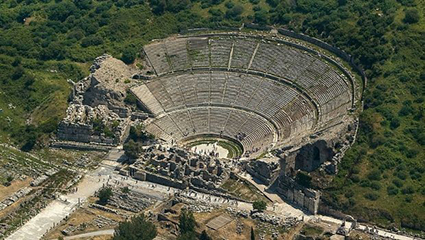
You will start at the upper (Magnesia) Gate, and work your way down through the city, ending near the ancient Harbor. Along the way, you will see the Forum, the Odeon, the Library of Celsus, the Thermal Baths of Scolastika, and the Great Theater, built in the Greek era and reconstructed in the Roman period. It has played host to programs as varied as Paul and his sermons to the Ephesians, to concerts by Sting, in part due to its remarkable acoustics.
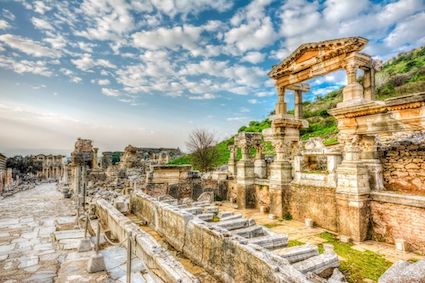
You will walk along the Arcadian Way, where once Mark Anthony and Cleopatra rode in procession. You will hear stories of Alexander the Great, the Virgin Mary, and many other famous visitors who walked the same marble streets that you are walking.
As you depart the Ephesus site, you will be able to view the hilltop ruins of the Basilica of St. John in the distance, which was erected over his grave in the 6th century A.D. by Emperor Justinian. The group will also visit the Temple of Artemis, whose former glory as one of the 7 Wonders of the World has been reduced to rubble after devastating pillage and plunder.
Food and Beverage
Not Included
Recommended Dress
Comfortable clothing and closed-toe, sensible walking shoes are recommended. Sunglasses, sunscreen, and a hat or umbrella are suggested.
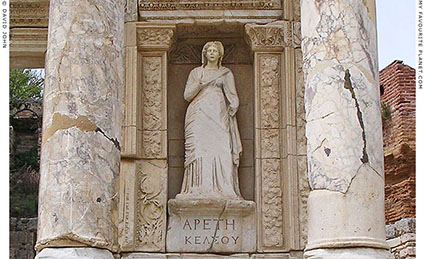
Restrictions
Walking at Ephesus is over actual streets / sidewalks from ancient times which are uneven and worn. There are steps without handrails and packed dirt that must be navigated in some areas. The walk through Ephesus is not wheelchair accessible.
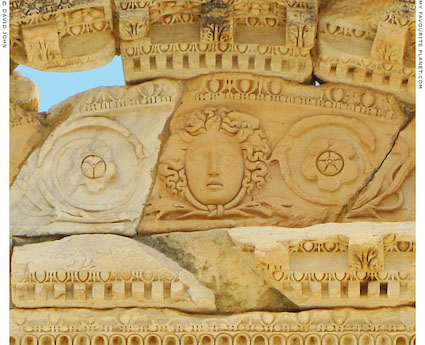
Meeting Instructions
Details will be provided on your ticket.
REGISTER HERE NOW
|
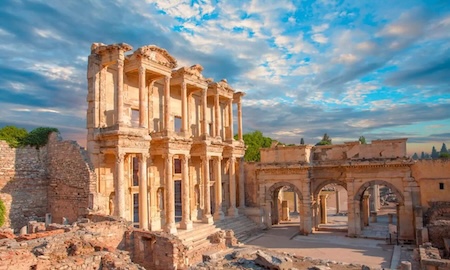
Legends of Ephesus
Artemis is the daughter of Leto and Zeus, and Apollo's twin. She is the goddess of the wilderness, the hunt, wild animals, and fertility. She is the midwives' helper and goddess of birth.
In one legend, Artemis was born one day before her brother Apollo. Right after her birth on the island of Ortygia, she helped her mother Leto to cross the straits to Delos, where Leto then delivered Apollo. Thus began Artemis' role as guardian of young children and patron of women in childbirth.
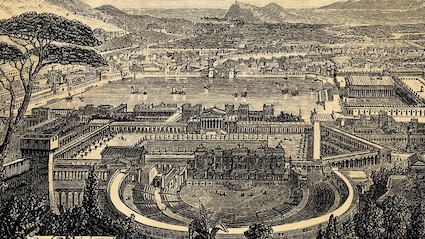
As a goddess of contradictions, Artemis protected women in labor, but her arrows brought them sudden death during childbirth. Like her twin brother Apollo, Artemis was a god of healing, but also brought and spread diseases.
The immortal Artemis and Apollo killed the children of the mortal Niobe, who had boasted to Leto (mother of the divine twins), that because she had more children than Leto, she was superior to her. When Apollo was outraged by this insult, the twin gods hunted and shot them with their bows and arrows. Apollo killed the male children and Artemis the females.
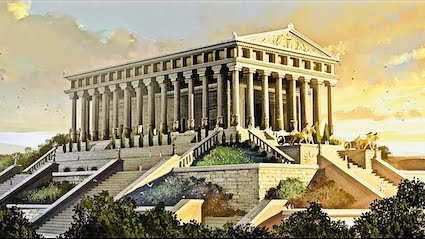
Artemis was worshiped in most Greek cities but only as a secondary deity. However, to Greeks in Asia Minor, she was a prominent deity. In Ephesus, a great temple was built in her honor—one of the "Seven Wonders of the Ancient World." There she was worshipped as a fertility goddess, and was identified with Cybele, the mother goddess of Eastern lands.
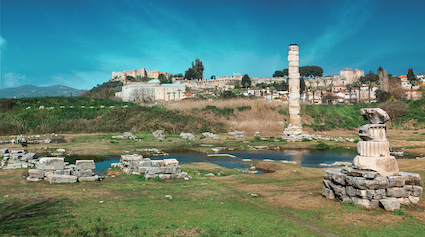
The cult statues of the Ephesian Artemis differ greatly from those of mainland Greece, where she is a huntress with bow and arrows. Those at Ephesus show her in the Eastern style, standing erect with numerous nodes on her chest.
Some say they are breasts, others say they are bulls testes sacrificed to her. Though the true interpretation remains uncertain, we can conclude that they represent fertility.
Artemis at an early age asked her father Zeus to grant her eternal chastity. Also all her companions were virgins. Artemis was very protective of her purity, and gravely punished any man who attempted to dishonor her. Actaeon, while hunting, accidentally came upon Artemis and her nymphs, bathing naked in a secluded pool. The stunned Actaeon stopped and gazed at them, but when Artemis saw him ogling them, she transformed him into a stag. Then she set his own hounds upon him.
They chased and killed what they thought was a stag, but it was really their master.
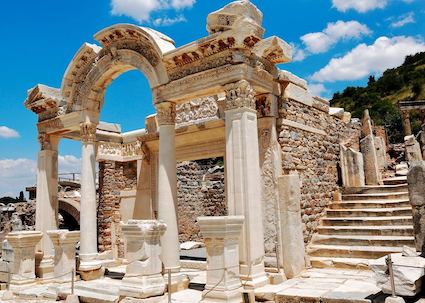
Legend is that Orion, a giant and a great hunter, tried to rape the virgin goddess, so she killed him with her bow and arrows. Another legend says she conjured up a scorpion which killed Orion and his dog. Orion became a constellation in the night sky, and his dog became Sirius, the dog star. Yet another version says the scorpion stung him and was transformed into the constellation Scorpio.
REGISTER HERE NOW
|
|
|
Istanbul, Turkey
"Tastes of Istanbul Cuisine"
($ Extra Charge for transportation and dinner)
Thu. Oct. 17, 2024
2-hour tour
Time TBD
Activity Level: Easy
Early-bird special rate expires anytime
REGISTER HERE NOW
Tour Description
Transportation to scenic and delicious Roof Mezze 360 Restaurant for Group Dinner.
Food and Beverage
Dinner is available for purchase by passengers.
Recommended Dress
Comfortable, sensible slip-on shoes are recommended. Sunscreen and sunglasses are suggested.
Restrictions
Guests must be able to get in and out of transportation.
Meeting Instructions
Details will be provided on your ticket.
REGISTER HERE NOW
|

Legendary Turkish Cuisine
Roof Mezze 360 captivates diners with its scenic rooftop vantage point overlooking Istanbul, a highlight for numerous visitors seeking a picturesque meal. Compliments abound for the restaurant's professional service, with staff providing thoughtful touches and swift attention to patrons.
The Turkish cuisine receives lauds for both its diversity and generous portions, enhancing the already spectacular dining atmosphere.
The restaurant delivers value through its combination of flavorsome meals, exceptional service, and ambient setting complete with live music.
REGISTER HERE NOW |
|
Istanbul, Turkey
"Jewels of the Bosphorus"
($ Extra Charge)
Fri. Oct. 18, 2024
9-hour tour
Time TBD
Activity Level: Easy
Early-bird special rate expires anytime
REGISTER HERE NOW
Tour Description
Set off on an orientation drive through the business center of the modern city, across the Galata Bridge, along the banks of the Golden Horn and under the Byzantine Aqueduct of Valens. Along the way, you will see the Saleymaniye Mosque, dedicated to Sultan Suleiman the Magnificent. You will continue around the mighty city walls, which once protected Constantinople from the many invasions and attacks it incurred over the centuries.
In the Old City, your first visit will be to the Byzantine Hippodrome, which was once one of the largest chariot race grounds of the Byzantine Empire.
Visit the Sultanahmet Mosque, where large groups of pilgrims commenced their pilgrimage to Mecca. It is decorated with 21,000 blue Iznik tiles giving it the nickname "The Blue Mosque."
You will then walk to the world-famous Grand Mosque of Hagia Sophia, formerly known as the Byzantine Church of Divine Wisdom, where you can marvel at the superb mosaics and the marble decorations.
Then you will walk through the immense gardens to experience typical Turkish cuisine in Galeyan restaurant located in the Old City.
After lunch, your tour will continue with a visit to the magnificent Topkapi Palace, the official residence of the Ottoman Sultans. See the famous treasury section, home to the Spoonmaker Diamond, the 7th biggest diamond in the world. Enter the kitchen buildings, today displaying the third richest collection in the world of Chinese and Japanese porcelain. From the palace, you will then visit the exotic Grand Bazaar area where you will have the chance to see a special demonstration on Turkish Carpets and have the opportunity for shopping. After your free time in the Bazaar, you will return to the pier.
Food and Beverage
Lunch is included.
Recommended Dress
When visiting religious sites, shoulders and knees should be covered. The Blue Mosque is a place of worship, and women are required to wear a head covering when entering. Head coverings are available at the Blue Mosque entrance at no charge. There is no need to cover the face as the covering is meant to hide a woman's hair only. Comfortable, sensible slip-on shoes are recommended. Sunscreen and sunglasses are suggested.
Restrictions
Walking is over cobblestone, tiled and paved surfaces. There are a few steps at the entrance to the Blue Mosque and at Hagia Sophia. Topkapi also has steps between the different sections of the palace.
Meeting Instructions
Details will be provided on your ticket.
REGISTER HERE NOW
|

Legend of the Angel and the Eagle
Overthrowing his rival Lisinus in Krizopolis (Üsküdar), Constantine one night dreamed that the Roman Empire was on the verge of collapse. The emperor decided to go to Ilion (Troy), the native city of the founder of ancient Rome, Ene, and build a new capital city there. Here Troy, the cradle of Rome, would be constructed in an even more beautiful way than it had been before. By the means of this Roman city, the collapse of the empire would be prevented.
Emperor Constantine started to determine the borders of the new capital; the tomb of Ajax was to be the center. Walls began to be built and the city’s gates were erected. At that moment the emperor had another dream in which a lady in rags and tatters was begging him for clothing.
Interpreters of the dream told him that he needed to bring a different ruined city into existence.
Constantine recalled that he had won his last military victory at Chalcedon (Kadıköy), and thus he began making measurements there instead, leaving the walls and towers of Troy only partly-finished. However, a glorious eagle that descended from the skies seized the measuring rope from the hands of the emperor and after crossing the sea, left it at the gates of the ancient city of Byzantium.
Constantine immediately understood the message from God and started his work anew by the walls of Byzantium, where the eagle had dropped the measuring rope, determining the boundaries of new Rome.
He was pacing slowly along the boundaries of the new capital city with a spear in his hand. The officials accompanying Constantine were surprised at how their emperor was pacing such a vast border, from to sea-to-sea, over the empty fields between the Golden Horn and the Marmara Sea. When they asked, “Your Majesty, will we go further?” Constantine replied them: “We will go until the one in front of me stops!” He was referring to an angel that his men could not see who was leading the way.
Finally, the angel stopped by the Marmara coast and the emperor determined the boundary of the city by stabbing his spear into the soil. Thus, the first borders of Constantinople were determined and the city walls were built according to this divine message. This legend about the establishment of the city answers the questions about how the city walls, which protected the city for centuries, from its time as Constantinople until the era of Ottoman Istanbul, were built.
According to popular belief, these city walls, which shielded the city during dozens of bloody battles and witnessed the conquest of Constantinople, were built in response to a divine sign. Moreover, the Byzantine emperors declared that the eagle in the legend was the symbol of their empire, thereby emphasizing that divine power always supported the city they had founded and the empire they governed.
REGISTER HERE NOW
|
|
Mykonos (Delos), Greece
"Birthplace of the Gods"
($ Extra Charge)
Sat. Oct. 19, 2024
5-hour tour
Time TBD
Activity Level: Easy
Early-bird special rate expires anytime
REGISTER HERE NOW
Tour Description
Take a 35-minute boat ride to the World Heritage site on the ancient island of Delos. World Heritage sites are selected and approved based on their value as the best examples of human creative genius, Delos, the birthplace of the immortals doesn't disappoint.
Once on the island, your English-speaking guide will take on a 2-hour 15 minute tour through the entire ancient city with its market places, public squares, the Temple of Apollo, the sanctuary of Artemis, the old town, and the amphitheater, and will walk you down the celebrated Lion Street.
You will also visit the museum of Delos and admire the Archaic, Classical, Hellenistic and Roman Sculptures, and a collection of vessels from all the periods.

Considered one of the most important mythological, historical, and archaeological sites in Greece, Delos held a position as a holy sanctuary millennia before Olympian Greek mythology made it the birthplace of the gods.
Delos is the mythical birthplace of Apollo — god of light and music — and his twin sister Artemis — the children of Zeus and Leto. This entire "Sacred Island" is now uninhabited, but ancient stones found on the grounds indicate that Delos was inhabited since the 3rd millennium BC.
The ruins of Delos are great in number and importance: the Sanctuary of Apollo complex, the Sacred Lake where the twin gods were born (which dried up in 1926), the Terrace of Lions, sanctuaries on Cynthus, the theater district, and commercial harbor district.
The tiny island of Delos opposite of Mykonos Island, where its Apollonian sanctuary was established since the 9th century B.C., was a center of culture well before the Golden Age of Pericles and the Parthenon. Time on Delos is forever frozen, and this tour offers the rare opportunity to stroll in the footsteps of the ancient Greek gods.
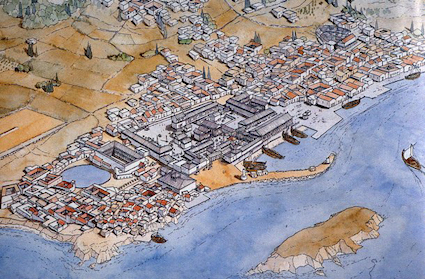
In this stark and lonely landscape, you will explore the ruins of an ancient settlement that once bustled with trade and commerce. Your guide will tell the tale while standing before the remnants of the Great Temple of Apollo. You will visit the island's most impressive highlights, from the Sanctuary of Apollo to the houses of Dionysus and Cleopatra.
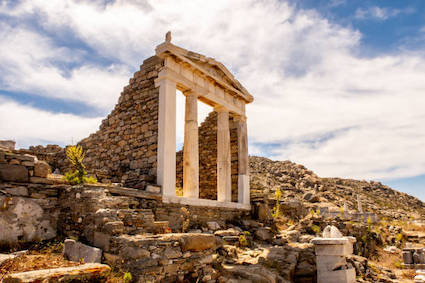
Tour the classical Theater, where over 5,000 citizens once cheered epic performances.
See Hellenistic mansions adorned with elaborate mosaics crafted thousands of years ago. Look out upon the greens and blues of the archipelago from the Terrace of the Foreign Gods and visit the lost Sacred Lake, which today stands dry, and where it is said that once swans and geese of Apollo frolicked.
As you stroll through the dry lake bed sheltered by greenery, and you breathe in the gentle divine energy that is so palpable, there is no doubt that you are walking on holy ground.
Those who have walked along the 164-foot-long Avenue of the Lions, with its five Naxian marble beasts crouching on their haunches, forelegs stiffly upright, vigilant guardians of the Sacred Lake, who have gazed at the marble columns of its temples, and have stood amidst the Agora and the remains of this once cosmopolitan Greek city, know why this unique island was named a World Heritage Site.
At the end of your tour and before you board the boat to return to Mykonos, you have some free time to take photos on the site before departing.
Food and Beverage
Not Included and not available on this uninhabited island.
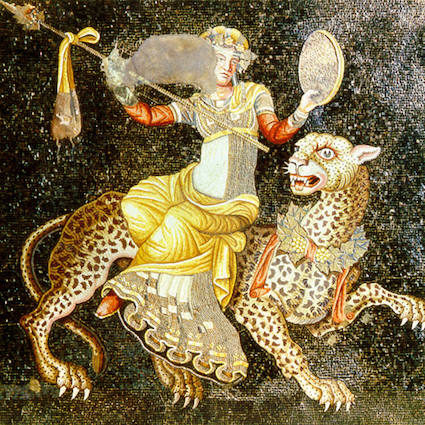
Recommended Dress
We recommend wearing comfortable clothing and sensible, flat-soled walking shoes. Sunscreen, hat or umbrella, and sunglasses are also recommended as it can get very hot on Delos. Please cover your knees and shoulders if visiting a religious site.
Restrictions
Guests must be able to walk over cobblestones and uneven surfaces, inclines and steps. Guests must be able to get in and out of transportation. This tour is not wheelchair accessible because of the varied terrain at the sites you will be visiting.
Meeting Instructions
Details will be provided on your ticket.
REGISTER HERE NOW
|

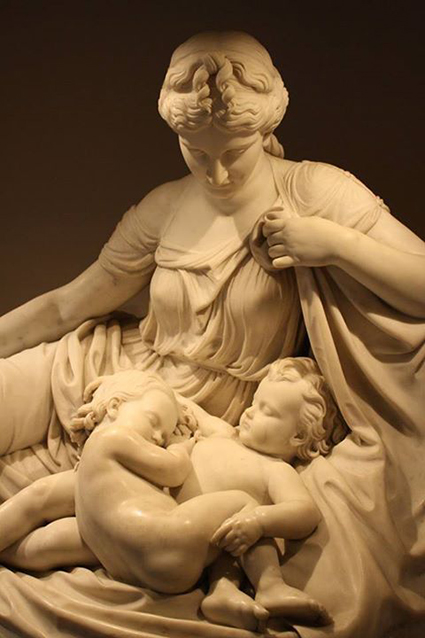
Legend of the Twins Apollo and Artemis
A small, rocky island in the center of the Aegean Sea, where, by law, no one is allowed to live, Delos was considered "the most sacred of all islands" in ancient Greek culture. According to legend, Apollo-Sun, god of daylight, and his twin sister Artemis-Moon, goddess of night light, were born here.
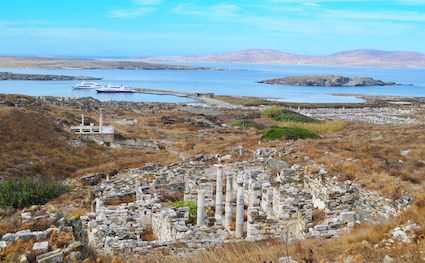
Where Leto gave birth to Zeus’s children Apollo and his twin sister Artemis, the sun shines brightly and illuminates both mind and soul. It is perhaps why, at this second "Navel of the Earth," like at its sister site Delphi, we can truly see ourselves.
Delos gave birth to Light, the most valued commodity in Greek civilization, and here the worship of the light-giving God Apollo was centered. This small rock in the middle of the vast sea became the most famed and sacred place in the known world for three centuries.
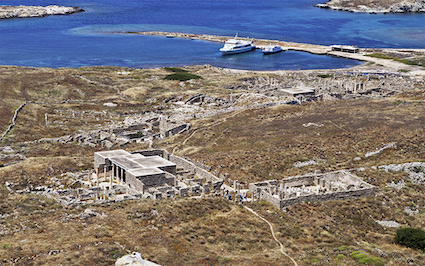
After the advent of Christanity, Delos was abandoned and over the years became deserted. Yet the deep footprints left by centuries of worship could not be erased by time nor neglect. Delos unveils itself with each sunrise, its soul unchanged, captivating, sacred. And when the light finally dips back into the sea at the end of the day, it stands alone and proud, softly whispering of its past grandeur.
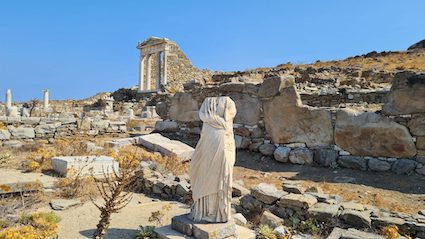
Delos is directly and tangibly associated with one of the principal myths of Hellenic civilisation. It was on this arid islet that Leto, impregnated by Zeus and fleeing the vengeance of Zeus's wife Hera, gave birth to Apollo and Artemis after a difficult labor. According to a Homeric hymn, the island, which until then had been floating, became anchored to the floor of the ocean.

The newborn Phoebus-Apollo threw off his swaddling clothes, bathed the universe in light, and began walking with his cither and bow. Kynthos, the mountain of Zeus, and the wheel-shaped lake, close to which Leto suffered labor pains for nine days and nights, remain essential landmarks of the island's sacred geography, which was clearly defined by the additions made to the Delian sanctuary to Apollo between the 6th and the 1st centuries B.C.
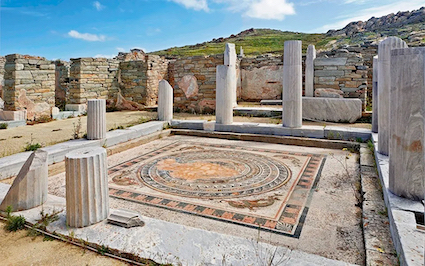
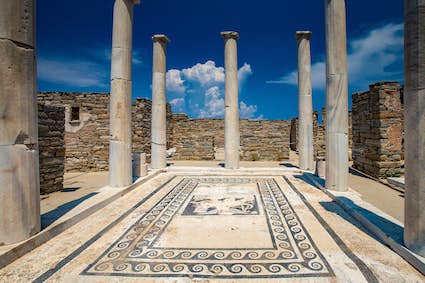
REGISTER HERE NOW |
|
Delphi, Greece
"Oracle of Delphi - Navel of the Earth"
($ Extra Charge)
Sun. Oct. 20, 2024
10 1/2 hour tour
Time TBD
Activity Level: Easy
Early-bird special rate expires anytime
Pickup at Cruise Terminal in Piraeus and dropoff at hotel.
REGISTER HERE NOW
Tour Description
Along the way to our journey to Delphi, you will see the plain of Beotia, an agricultural center surrounded by cotton plantations and you will also pass through the city of Theva (Thebes), the birthplace of King Oedipus. You will continue towards Mt. Parnassos, making a brief rest stop outside the town of Levadia.
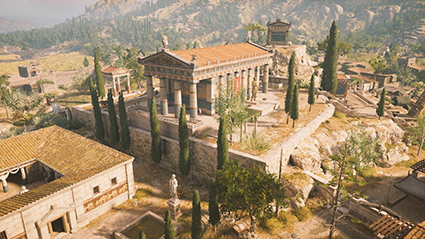
You will then drive on to Delphi, which dates to the ninth century B.C. and whose allure includes an amazing hillside setting and ruins that will intrigue even the most skeptical.
Delphi was the home of the Oracle of Delphi (the Greek world's most important oracle), and the priestess Pythia, famed throughout the ancient world for divining the future and for consulting in all major undertakings.
The area was a religious sanctuary dedicated to the Greek god Apollo after he slew the Python, a deity who protected the navel of the Earth (center of the world) in this location. The sanctuary was home of the Pythian Games, the second most important games in Greece after the Olympics.
You will see the Roman Agora, walk along the Sacred Way, and view the monument of the Argive Kings. the treasury of the Athenians, the Athenian Stoa, the Polygonal Wall, the monument of Platea, and the Temple of Apollo where the oracle resided.
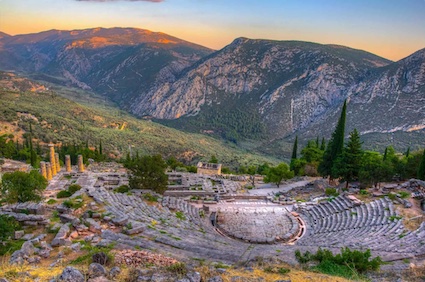
Above the Temple, you can visit the well preserved 3rd-century Theater. On the lower slope of the mountain is the Tholos, a building whose exact purpose is unknown but architecturally speaking is considered one of the masterpieces of the ancient world. You will also see the Palestra where the athletes trained in preparation for the Pythian Games.
After you visit the archeological site, you will visit the adjacent Delphi Archaeological museum which houses the ancient artifacts that were found at the site. As its centerpiece, are the antiquities found in the complex of Oracle which dates from the 18th century B.C. when the oracle was founded to its decline around 300 A.D. Exhibits include the frieze of the Treasury of the Sifnians, the Naxian Sphinx, the metopes of the Athenian treasury, the famous Charioteer, created to commemorate a victory during the 476 B.C. Pythian Games, and many other artifacts.
When visitors approached Delphi, the first structure they saw was the sanctuary of Athena Pronaia — meaning, "Athena who is before the temple (of Apollo)." This sanctuary contained the most characteristic monument at Delphi: the Tholos, a circular building with a conical roof supported by a ring of outer columns.
Visitors would then walk along the Sacred Way, a path to the sanctuary of Apollo that was lined with treasuries and votive monuments.
The central and most important part of Delphi is the temple of Apollo, where the Pythia delivered her prophetic words in the adyton, a separate, restricted room at the rear. The temple of Apollo sat atop a large terrace supported by a polygonal wall.
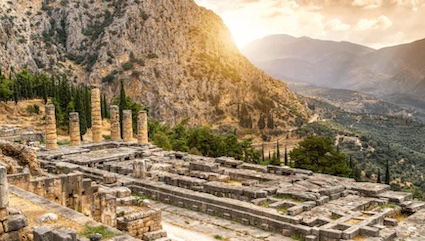
As you tour the site with your professional guide, they will bring to life the history and central characters of the site. You will see the Roman Agora, walk along the Sacred Way, and view the monument of the Argive Kings, the treasury of the Athenians, the Athenian Stoa, the Polygonal Wall, the monument of Platea, and the Temple of Apollo where the oracle resided.
Above the Temple, you can visit the well preserved 3rd-century Theater. On the lower slope of the mountain is the Tholos, a building whose purpose is unknown but architecturally speaking is considered one of the masterpieces of the ancient world. You will also see the Palestra where the athletes trained in preparation for the Pythian Games.
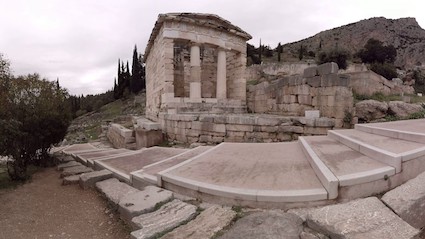
After you tour the site, you will visit the adjacent Delphi Archaeological museum, housing ancient artifacts found at the site. Its centerpiece are antiquities from the Oracle complex, which dates from the 18th century B.C. until its decline around 300 A.D. Exhibits include the frieze of the Treasury of the Sifnians, the Naxian Sphinx, the metopes of the Athenian treasury, and the Charioteer, created to commemorate a victory during the 476 B.C. Pythian Games.
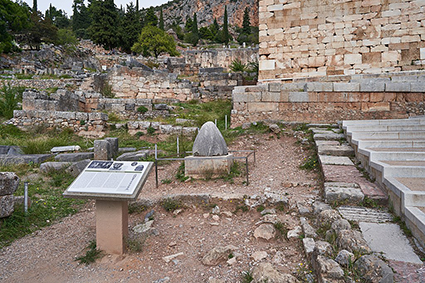
After you visit the museum, rejoin your transportation and begin the drive back to Athens. Along the way, a stop will be made for a traditional Greek lunch with wine. After lunch, you will start your drive back to the port of Piraeus.
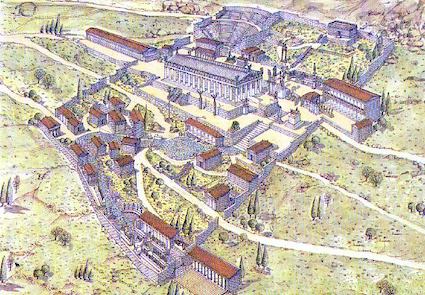
Please Note
The drive to and from Delphi is approximately 3 hours each way. Stops will be made along the way. The site of Delphi is perched on the side of a steep hill and is visited by uphill walking. Those who make the climb are rewarded with a beautiful view over the site and the valley beyond.
Food and Beverage
A traditional Greek lunch with wine is included.
Recommended Dress
Comfortable clothing, sensible, flat-soled walking shoes, sunglasses, sunscreen, and hat or umbrella are suggested.
Restrictions
The hillside site of Delphi requires almost continuous uphill walking over dirt and some paved surfaces to visit. Guests must be in good health and sensible walking shoes are a must. At the museum, there are steps to enter the building.
Meeting Instructions
Details will be provided on your ticket.
REGISTER HERE NOW
|
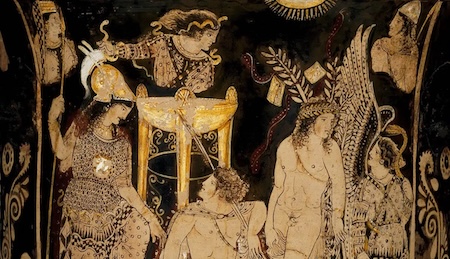
Legend of the Oracle
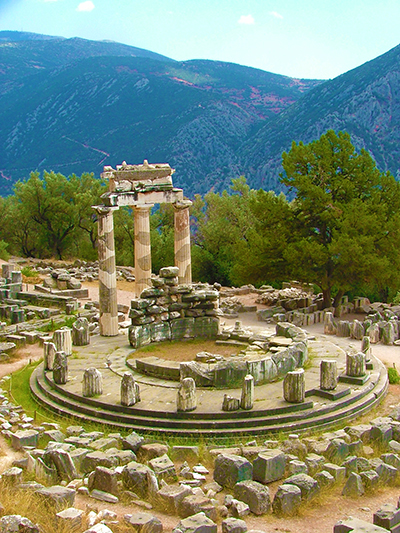
According to Ancient Greek myths, the god Zeus launched two eagles from the two ends of the world, one to the east and the other to the west, in order to find the center of the earth. The eagles, starting simultaneously and flying at equal speed, crossed paths above Delphi. Zeus marked the spot with a sacred stone called the omphalos (meaning "navel"), which was later held at the sanctuary of Apollo. Since then, Delphi has been considered to be the center of the world, the omphalos—"Navel of the Earth."
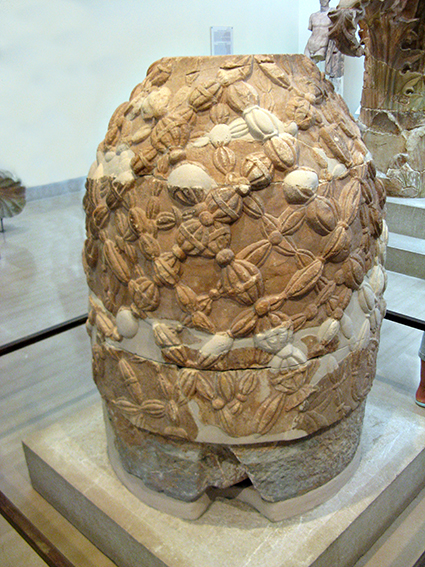
The omphalos is an ancient marble artifact, found at the archaeological site. The original stone is held in the museum of Delphi. A simplified copy sits outdoors at the site where it was found.
In the 2nd century A.D., Pausanias traveled to Delphi and provided rare evidence through his work.
The oval-shaped stone of the omphalos seems to have been decorated in high relief. In ancient times it may have been covered by a mesh of wool cloth, and was kept in the adyton (inner sanctum), beside the tripod and the daphne (bay leaves)—the other sacred symbols of the god. Pausanias described the wool cloth that covered the stone held precious stones designed in the shape of a mermaid, while two gilded eagles were fixed on top of it.
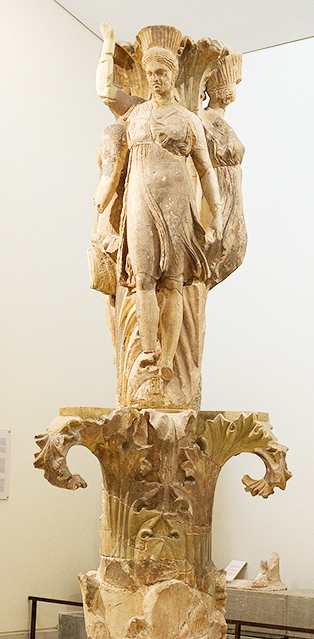
Recent studies by French archaeologists have shown that the omphalos and columns were connected and interlocked. The stone navel was mounted on the bronze tripods supported by the three dancers at the top of the column. This is where the omphalos is thought to have been placed, as a cover of the column, in order to reinforce the meaning and importance of the Athenian votive offering symbolically. The Athenians, wanting to placate and honor the god of light, offered Apollo this copy of the original stone, which combined both Delphic symbols as a gift from the hands of the three priestess figures.
Greeks believed the site was sacred and belonged to Gaia, or Mother Earth, and was guarded by Gaia’s serpent child, Python. Apollo killed Python and founded his oracle there.
According to legend, natives of the island of Crete, accompanied by Apollo in the guise of a dolphin, arrived at the port of Delphi (Kirrha) and built the god’s sanctuary.
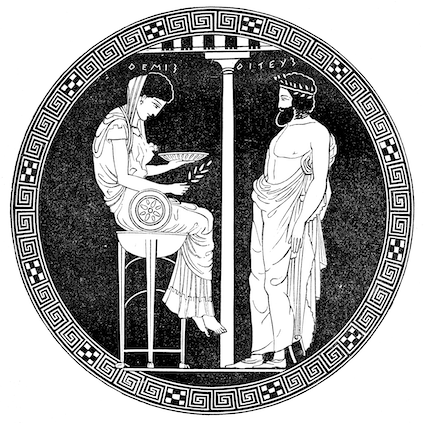
The prestige of the Oracle of Delphi was at its height between the 6th and 4th centuries B.C.
Delphi became a powerful entity, with both rulers and common folk seeking counseling with the Pythia, who only operated a limited number of days over 9 months of the year. These pilgrims brought lavish gifts and offerings. Due to high demand for the oracle's services, affluent people paid great sums to skip to the front of the line. The Oracle was consulted on both private matters and affairs of state. City-state rulers sought advice before launching wars or founding new Greek colonies.
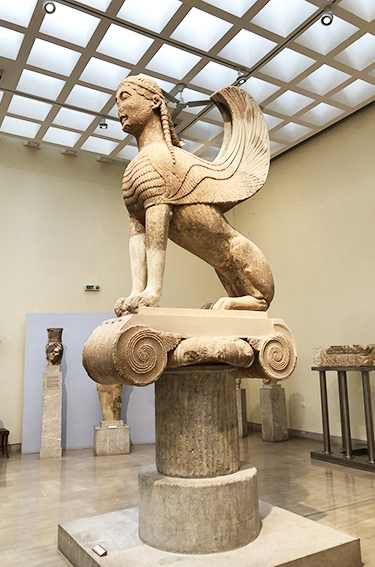
For these consultations, the Pythia would enter the adyton and then sit on a tripod chair, possibly behind a curtain. After Apollo’s priests relayed questions posted by petitioners, the Pythia would inhale light hydrocarbon gasses that escaped from a chasm in the ground, falling into a trance.
The Pythia would then mutter incomprehensible words, which the Apollo priests would translate sometimes conflicting messages for petitioners.
Greeks believed the Oracle of Delphi existed since the dawn of time and accurately predicted historical events such as the Argonaut’s expedition and Trojan War.
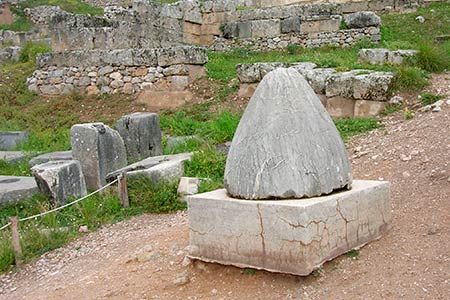
REGISTER HERE NOW
|
 |
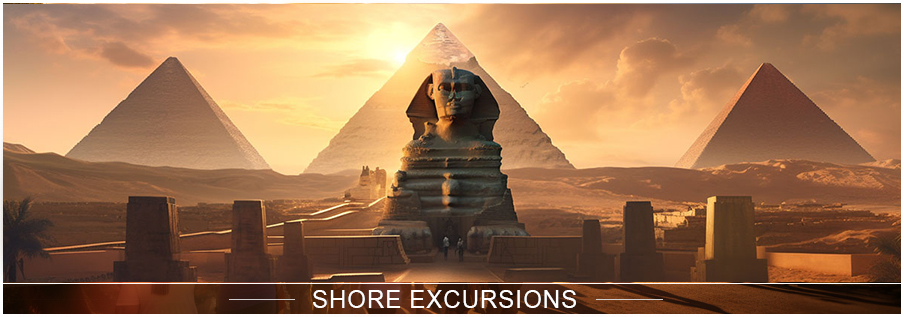


![]()








































